An enormous number of companies are competing in the rapidly growing generative AI (genAI) sector, from well-established firms adding generative AI to their toolkits to innovative startups equipped with fresh ideas. With the genAI market expanding so quickly, it can be difficult to distinguish between the leading generative AI companies and the hundreds of other players tapping into this flourishing ecosystem. Here are our picks for the top eight generative AI companies, their key products, and potential use cases that set them apart:
- OpenAI: Best Overall
- Microsoft: Best Enterprise Generative AI Partner
- Alphabet (Google): Best for Integrated Generative AI Solutions
- Anthropic: Best for Generative AI Safety and Explainability
- Hugging Face: Best for Community-Driven Generative AI Development
- Meta: Best for Advertisers
- Synthesia: Best Generative AI Video Company
- Guidde: Best for Automated Tutorials
Featured Partners: AI Software
Top Generative AI Companies Compared
The following table provides an at-a-glance overview of the top eight generative AI companies and their products.
| Headquarters | Founded | Latest employee count | Key Products | Latest Market cap* | |
|---|---|---|---|---|---|
| OpenAI | San Francisco, CA | 2015 | 200-500 employees + over 6,000 associated members | GPT-4o, ChatGPT, DALL-E 3, Sora | Private company valued at $80 billion+ |
| Microsoft | Redmond, WA | 1975 | 10,000 employees + over 239,000 associated members | Microsoft Copilot Studio, Azure AI Studio | $2.90 trillion |
| Alphabet (Google) | Mountain View, CA | 1998 | 10,000 employees + over 300,000 associated members | Gemini, Vertex AI, LaMDA, PaLM 2 | $2.14 trillion |
| Anthropic | San Francisco, CA | 2021 | 500-1000 employees + over 1000 associated members | Claude 3.7 Sonnet, Claude API | Private company valued at $61.5 billion |
| Hugging Face | Brooklyn, NY | 2016 | ~500 employees + over 500 associated members | BLOOM, AutoTrain, Inference Endpoints | Private company valued at $4.5 billion |
| Meta | Menlo Park, CA | 2004 | 10,000 employees + over 120,000 associated members | Meta AI, Llama 2, Llama 3.3, Seamless Communication models | $1.67 trillion |
| Synthesia | London, England | 2017 | 200-500 employees + 470 associated members | Synthesia | Private company valued at $2.1 billion |
| Guidde | Belmont, CA | 2020 | 11-50 employees | Guidde | Private company valued at 30 million |
*Latest market cap is reported as of March 2025.
TABLE OF CONTENTS

OpenAI
Best overall
- Headquarters: San Francisco, CA
- Founded: 2015
- Latest employee count: 6,000+ employees
- Key products: GPT-4o, ChatGPT, DALL-E 3, Sora
- Latest market cap: Private company valued at $157 billion
Ever since OpenAI publicly launched ChatGPT in late 2022, it has continued to shape the generative AI landscape. It is the most successful dedicated generative AI company to date, worth an estimated $80 billion and backed by major tech companies, including Microsoft. The company is reportedly in discussions to raise up to $40 billion in funding led by SoftBank Group, which would value OpenAI at approximately $300 billion.
Beyond its flagship content generation solution, ChatGPT, and image generation solution, DALL-E, OpenAI offers its API and generative AI models to support companies in their own AI endeavors. The company’s GPT-4 and GPT4o, chat models, fine-tuning models, image models, and embedding models can all be customized for a usage fee to meet individual business needs.
Earlier in 2024, the company launched the generative AI video solution Sora, as well as the GPT Store, which is designed to make it easier for users to select custom-built versions of ChatGPT that align with their goals. Also, OpenAI’s real-time web search feature is live and fully integrated into ChatGPT. Initially introduced as a prototype named “SearchGPT” in July 2024, this functionality has since been incorporated directly into ChatGPT, enhancing its ability to provide up-to-date information.
Why We Picked OpenAI
We selected OpenAI for its influential role in shaping the generative AI landscape, particularly through its widely adopted models like GPT-4 and DALL-E. It offers a variety of tools that cater to diverse business needs — from text and image generation to more specialized applications like video content creation with Sora. The company’s recent introduction of real-time search promises to bring even more advanced functionalities to users seeking deeper AI customization.
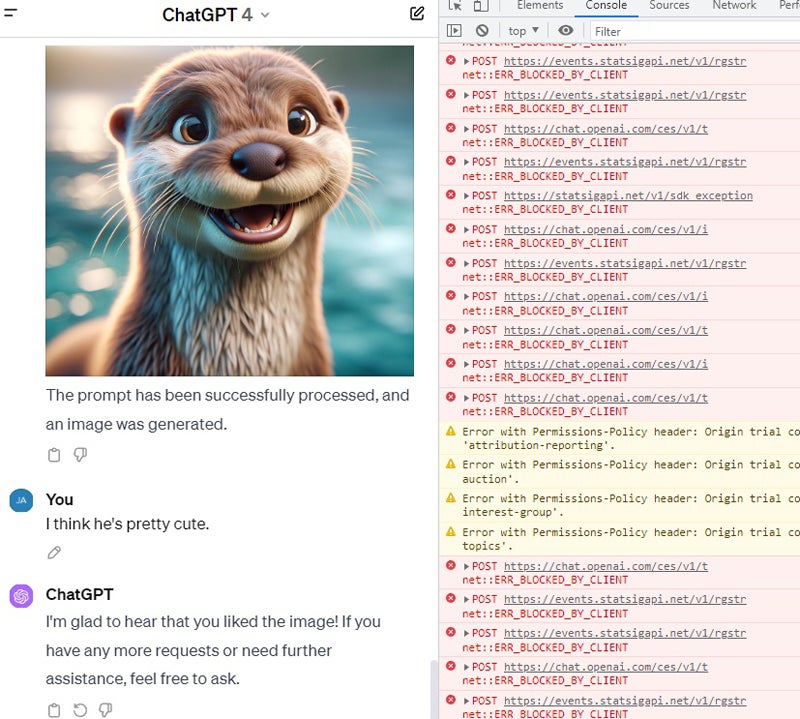
Pros and Cons
| Pros | Cons |
|---|---|
| Well-funded, innovative company | No real-time information informing results in free tool |
| General availability of APIs and fine-tuning models | Usage-based model access can become expensive |
| Wide range of customizable AI models for various applications | Data privacy concerns for sensitive information |
Pricing
OpenAI offers a range of products with different subscription and usage-based pricing options. For instance, ChatGPT has the following plans:
- Free: No cost
- Plus: $20 per user, per month
- Pro: $200 per month
- Team: $25-$30 per user, per month
- Enterprise: Contact sales team for customization
Features
- ChatGPT offers multimodal outputs based on GPT-4/4o or GPT-4o mini, depending on selected plan
- DALL-E family of tools for image generation
- APIs, base, embedding, and fine-tuning models
- Sora for text-to-video content generation
- GPT Store for ChatGPT customizations
Read Top 20 Generative AI Tools and Apps to learn more about today’s leading content creation tools.

Microsoft
Best for enterprise generative AI tools
- Headquarters: Redmond, WA
- Founded: 1975
- Latest Employee Count: 239,000+ employees
- Key Products: Microsoft Copilot, Microsoft Copilot Studio, Azure AI Foundry
- Latest Market Cap: $2.96 trillion
Microsoft has drawn on its extensive software legacy to develop many of its own AI tools, while also supporting new technologies, particularly generative AI from OpenAI. Bing, the Microsoft-owned search engine, was the first major search engine to incorporate generative AI functions via chatbot, and Microsoft’s family of Copilot technologies is one of the farthest-reaching generative AI assistants on the market today.
Copilot is embedded in many of Microsoft’s widely used enterprise tools, which are already among the most popular business applications in the world. The company also offers Azure AI Studio, a platform where developers can build, test, and deploy generative AI applications using models by Microsoft, Meta, Hugging Face, and OpenAI, among others.
Why We Picked Microsoft
We chose Microsoft for its broad integration of generative AI across its product portfolio, making it a strong option for enterprise-level AI solutions. Microsoft’s Copilot tools are built into widely used applications like Microsoft 365 and Dynamics 365, offering practical AI-driven features that cater to various business needs. Microsoft’s partnership with OpenAI also contributes to the wider development of generative AI tools, supporting the growing ecosystem and the availability of these technologies.
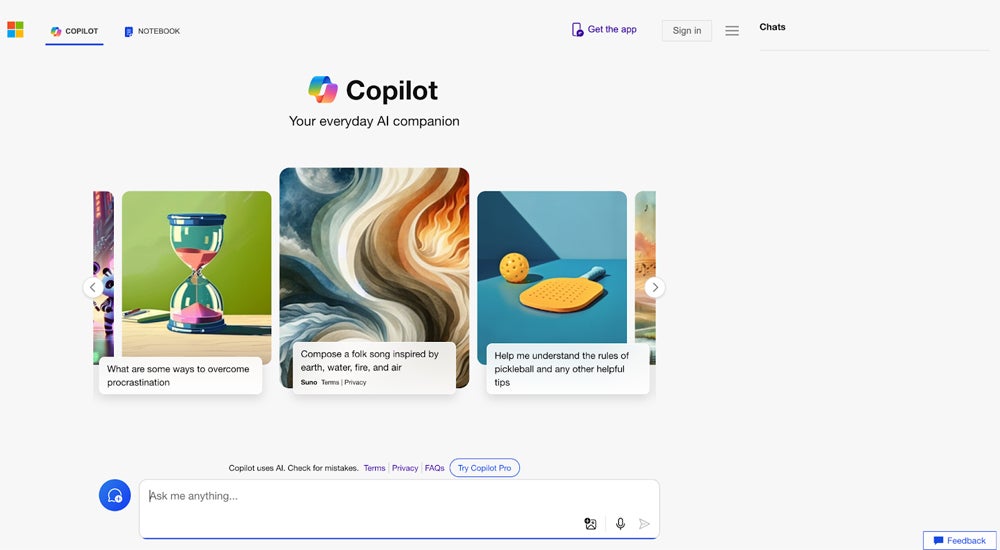
Pros and Cons
| Pros | Cons |
|---|---|
| Efficient generative AI integration with Microsoft products | Expensive solutions, especially for larger teams |
| Partnership with OpenAI | Limited usability outside of Microsoft-owned products |
| Extensive enterprise support and security features | Complex licensing structure |
Pricing
Microsoft offers a range of generative AI tools with varying pricing models. Some tools can be purchased directly, while others are included as part of a Microsoft subscription:
- Microsoft Copilot: Free for the baseline version, $20 per user, per month for Microsoft Copilot Pro
- Copilot for Microsoft 365: $30 per user, per month (paid annually)
- Microsoft Copilot Studio: $200 per tenant, per month
- GitHub Copilot: Free version; paid plans range from $10-$19 per user, per month
- Microsoft Copilot for Sales: $50 per user, per month (paid annually)
Features
- Copilot in Microsoft 365 apps (Word, Excel, Outlook)
- AI automation in Dynamics 365
- Custom AI in Copilot Studio and Azure AI Studio
- AI insights in Power BI
- GitHub Copilot for coding
- System-wide AI in Windows 11
Read about today’s leading AI companies for a full portrait of the companies defining a new industry.

Alphabet (Google)
Best for online, integrated generative AI solutions
- Headquarters: Mountain View, CA
- Founded: 1998
- Latest Employee Count: 303,000+ employees
- Key Products: Gemini, Vertex AI, Gemini for Google Workspace
- Latest Market Cap: $2.14 trillion
Google has generated considerable buzz around its generative AI capabilities with its release of Gemini AI chatbot, a collection of generative AI models that combine the strengths of Google’s previous models, LaMDA and PaLM 2. This enables Gemini to create more contextually aware content using text, images, code, or speech.
Whether you choose the free or paid version of Gemini, you can enter queries in various formats and receive responses in your preferred format — often with relevant web pages and images included. Gemini users also benefit from quality management and fact-checking features like its double-check system. Additionally, Gemini allows you to turn on Google extensions to pull in relevant information from services like Google Flights, Hotels, Maps, Workspace, and YouTube.
Google says it remains focused on developing artificial intelligence, with an emphasis on scalability and ethics. Its AI principles were established in 2017 to guide responsible AI development, and Google regularly releases reports on how the company is applying these principles.
Why We Picked Alphabet
Google made it onto our list for its role in integrating generative AI into widely used platforms. LaMDA and PaLM 2 have been hugely influential in moving natural language processing (NLP) and AI-driven content generation forward. Gemini builds on the strengths of these AI models and integrates them into apps and services used by millions of people everyday, making generative AI both convenient and widely accessible. Likewise, the integration of Gemini into Google Workspace gives business users practical access to generative AI in their daily work.
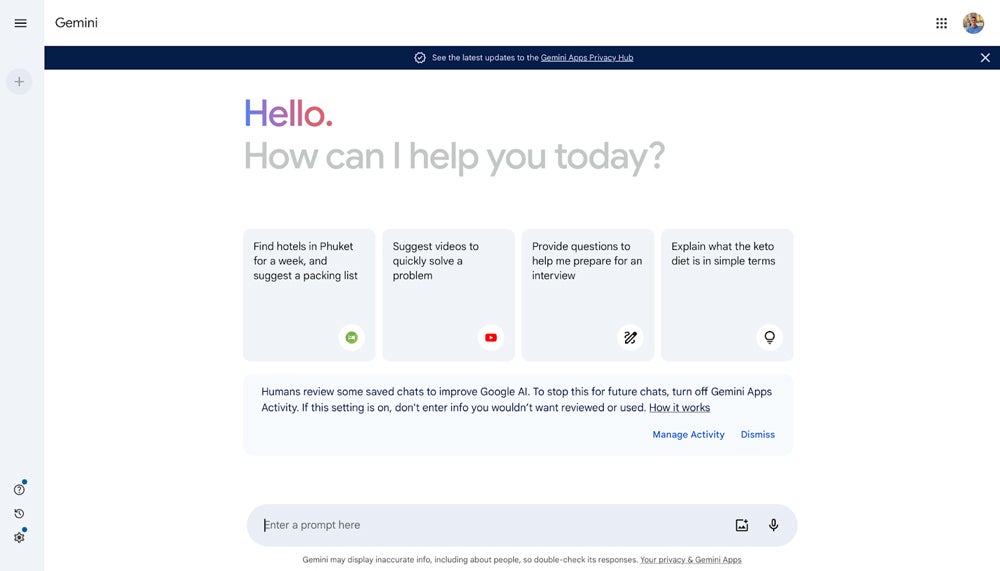
Pros and Cons
| Pros | Cons |
|---|---|
| Integration with Google Search and apps | Some image output concerns and issues |
| Comprehensive quality management features | Some issues with logical outputs and query responses |
| Extensive multimodal capabilities for handling different input types | Limited customization options for AI-generated content in some tools |
Pricing
- Gemini: Free
- Gemini Advanced: Available through the Google One AI Premium subscription $19.99 per month, which includes 2 TB of storage
- Gemini Business for Google Workspace: Included in the Google Workspace Business Plan, priced at $14 per user per month with Gemini AI features integrated
- Gemini Enterprise for Google Workspace: Included in the Google Workspace Enterprise plan, priced at $30 per user, per month
- Gemini 1.5 Flash API: Free through Google AI Studio with lower rate limits for testing purposes
- Gemini 1.5 Pro API: Available through Google AI Studio’s paid tier at $1.25 per 1 million input tokens and $5.00 per 1 million output tokens for up to 128 tokens
Features
- Gemini 1.5 in Ultra, Pro, Nano, and Flash versions
- AI Overviews in Google Search
- Multimodal inputs and outputs with integrated fact-checking
- AI integration across Google Workspace
- Mobile version for iOS and Android users

Anthropic
Best for generative AI safety and explainability
- Headquarters: San Francisco, CA
- Founded: 2021
- Latest Employee Count: 1,200+ employees
- Key Products: Claude 3.7 Sonnet, Claude API
- Latest Market Cap: Private company valued at $61.5 billion
Anthropic is a generative AI startup that explicitly prioritizes AI safety and accountability in its research. Its flagship product is Claude, an LLM-based AI assistant that offers one of the largest context windows available among generative AI models and chatbots. Anthropic’s team is made up of AI researchers and engineers in addition to policy experts, business leaders, and stakeholders from across government, academic, nonprofit, and industrial sectors.
Claude is flexible and can be tailored for tasks like automating workflows, chatting in natural language, processing text, or answering questions. The latest Claude 3.7 Sonnet model is notable for its “hybrid reasoning” capability, allowing it to switch between rapid responses and extended, in-depth thinking within a single system.
Why We Picked Anthropic
We picked Anthropic for its strong emphasis on AI safety and explainability, which is particularly important for businesses focused on ethical AI deployment. Claude’s ability to handle complex, context-rich tasks with a large context window makes it an attractive option for organizations needing detailed or nuanced AI-generated content. Likewise, Anthropic’s transparency in AI development—and focus on producing balanced and accurate outputs—provides confidence in Claude’s consistency and reliability.
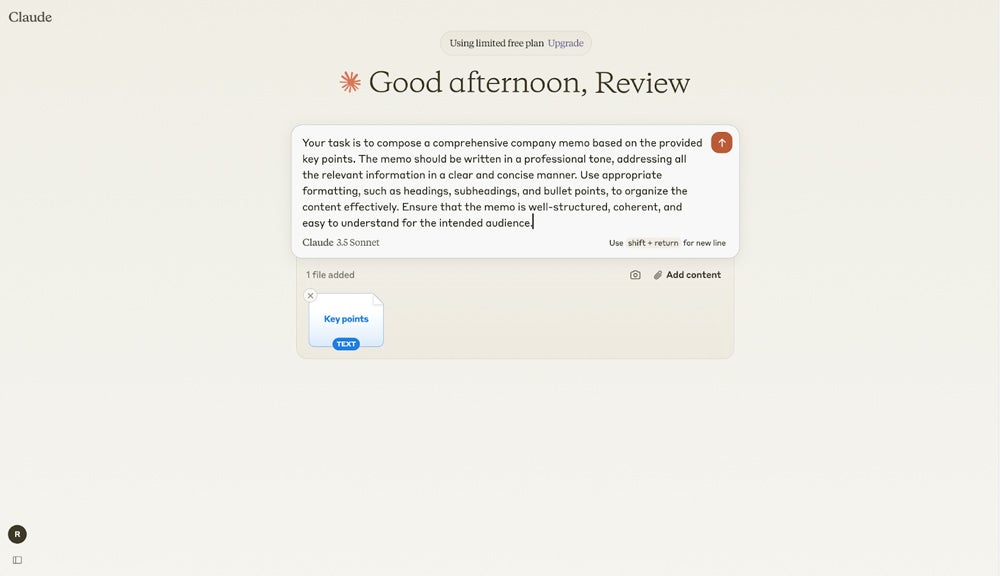
Pros and Cons
| Pros | Cons |
|---|---|
| Focused on transparent, explainable AI R&D | Expensive per-token pricing for Claude 3 |
| Claude balances utility with appropriate/inoffensive responses | Claude cannot access the Internet for search |
| 200K context window supports detailed, long-form interactions | Limited feature availability outside the U.S. |
Pricing
Anthropic offers a combination of tiered subscription plans and usage-based plans.
- Claude.ai Free Plan: Free via web, Android, and iOS
- Claude.ai Pro Plan: $20 per person, per month; includes access to Claude 3 Opus and Haiku, higher usage limits, project creation tools, priority bandwidth and availability, and early access to new features
- Claude.ai Team Plan: $25 per person, per month; includes higher usage limits, team sharing and discovery features, central billing, and administration
- Claude.ai Enterprise: Custom
- API Build plan: Free; access to all Claude model versions
- API Scale plan: Pricing available upon request
- Claude 3 Haiku: $0.25 per million input tokens, $1.25 per million output tokens
- Claude 3.5 Sonnet: $3 per million input tokens, $15 per million output tokens
- Claude 3 Opus: $15 per million input tokens, $75 per million output tokens
Features
- Extensive AI research library
- Free, multimodal content generation via Claude.ai
- API access for multiple Claude versions
- Three Claude 3 versions: Haiku, Sonnet, and Opus
- Hefty 200k context window
Read genAI vs. predictive AI to get a better idea of the two technologies.

Hugging Face
Best for Community-Driven Generative AI Development
- Headquarters: Brooklyn, NY
- Founded: 2016
- Latest employee count: Nearly 500 employees
- Key products: BLOOM, AutoTrain, Inference Endpoints
- Latest market cap: Private company valued at $4.5 billio
Hugging Face is a platform and community focused on AI and machine learning model development. The platform is widely used in the AI community for both research and practical applications and provides a wide range of pre-trained models and datasets. Many large enterprises and AI startups use Hugging Face to tinker with existing models and develop new ones from scratch.
Although the forum is designed with developers in mind, certain Hugging Face solutions, like AutoTrain, require little to no coding. Others, like BLOOM, also offer different levels of accessibility as well as the ability to generate content in a variety of human and computer languages. Hugging Face has some of the widest multilingual coverage on the market today.
Why We Picked Hugging Face
Hugging Face makes our list for its focus on community collaboration and open source AI development, which makes it a great option for businesses that want to build or customize AI models without having to start from scratch. The platform provides a broad range of pre-trained models and datasets that allow businesses to hit the ground running with their own AI development. It also offers no-code tools like AutoTrain, which makes it possible to build and deploy AI models with zero coding expertise.
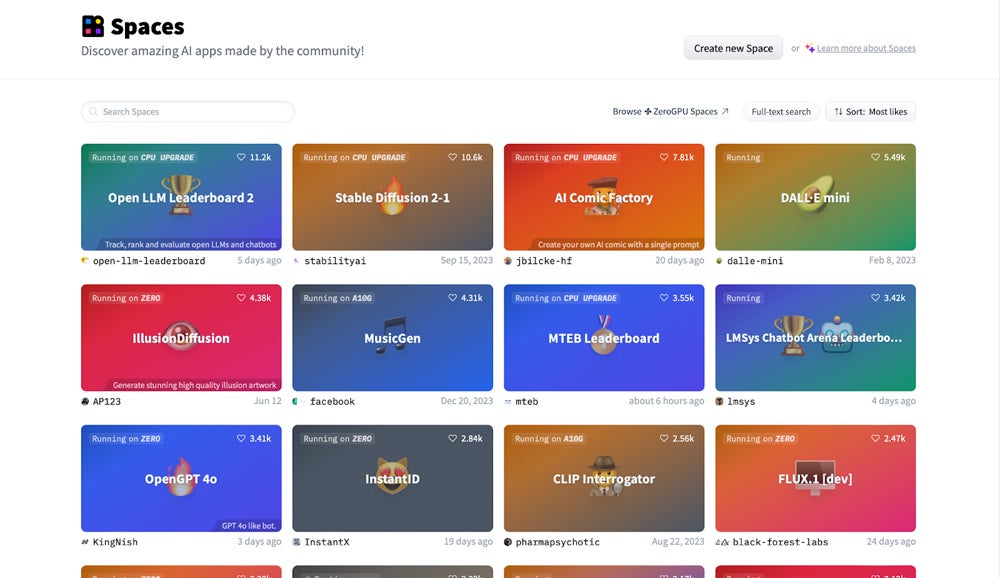
Pros and Cons
| Pros | Cons |
|---|---|
| Open-source, collaborative development environment | Less friendly to non-technical users |
| Embeddable generative AI technology for affordable scalability | Limited governance over third-party development tools, like Stable Diffusion |
| Wide range of pre-trained models available for immediate use | High computational cost for large-scale model deployments |
Pricing
Hugging Face offers five plans with the following pricing:
- Hugging Face Hub: Free
- Pro Account: $9 per month
- Enterprise Hub: Starts at $20 per user, per month
- Spaces Hardware: Starts at $0 per hour
- Inference Endpoints: Starts at $0.032 per hour
Features
- Community-driven support and resources
- BLOOM multilingual content generation in 46 languages and 13 programming languages
- Access to most LLMs
- Text generation and logical text completion
- Learned subword tokenizer

Meta
Best for Advertisers
- Headquarters: Menlo Park, CA
- Founded: 2004
- Latest employee count: 124,000+ employees
- Key products: Meta AI, Llama 2, Llama 3.3, Seamless Communication models
- Latest market cap: $1.67 trillion
Meta’s flagship generative AI model is Llama 3, an open-source LLM available to any business or developer who wishes to integrate it into their products. The latest iteration, Llama 3.3, features 70 billion parameters and offers capabilities comparable to the earlier Llama 3.1 model, which had 405 billion parameters, thereby reducing computational requirements and associated costs.
A key focus for Meta has been integrating generative AI into its popular social media platforms, including Facebook, Instagram, and WhatsApp. The company’s Meta AI chatbot uses the Llama 3 model to facilitate more dynamic interactions with, and provide tailored content recommendations for, platform users. For advertisers, Meta has introduced tools designed to automate parts of the ad creation process and improve ad performance, such as image and text generation capabilities and options for customizing ads based on user engagement data.
Why We Picked Meta
We chose Meta for its effective integration of generative AI across Facebook, Instagram, and WhatsApp, which is useful for any business that uses social media to connect with their customers. The fact that Llama 3.1 is open source means that developers can customize and adapt the model to fit specific needs, while Meta’s advertising features make it simple for marketers to create and optimize ads based on user engagement. Meta also provides tools to help manage AI use responsibly, offering some reassurance for businesses concerned about security and ethical issues.
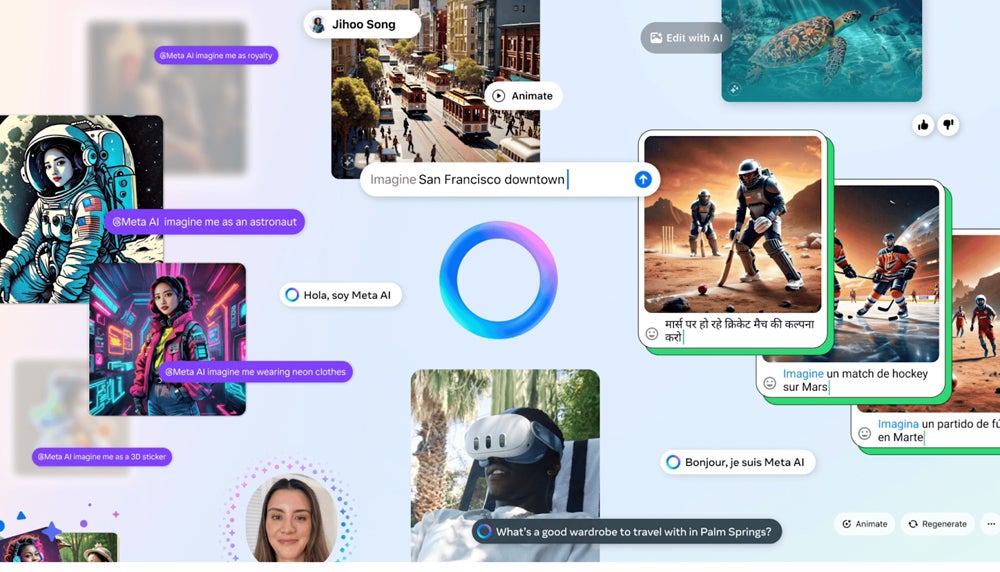
Pros and Cons
| Pros | Cons |
|---|---|
| Extensive open source research and resource libraries | Some model parameter and performance limitations |
| Supports multiple languages and extended context | Less accurate than some competitors in precision tasks |
| Integrated across Meta platforms for easy use and broad reach | Learning curve for open-source models |
Pricing
Most generative AI solutions from Meta are free and open source.
- Llama models: Open-source and freely available for businesses and developers
- Meta AI Assistant: Integrated into platforms like Facebook, Instagram, and WhatsApp
Features
- Open-source Llama 3.3 platform for AI modeling
- Meta AI assistant in Instagram, Facebook Messenger, and WhatsApp
- Extensive AI research and resources libraries
- Llama Guard and Prompt Guard safety features
- AI image and text generation tools for advertisers

Synthesia
Best generative AI video company
- Headquarters: London, England
- Founded: 2017
- Latest Employee Count: 450+ employees
- Key Products: Synthesia
- Latest Market Cap: Private company valued at $2.1 billion
Synthesia is an AI video generation company that helps businesses create high-quality video content for digital marketing, training, and other use cases with minimal upfront effort. The platform offers various AI avatars and voices to help bring video to life, without requiring extensive editing expertise. For users who aren’t happy with the preexisting avatar options, there’s a feature that allows them to create a custom one based on their own (or someone else’s) likeness.
Synthesia’s customers consistently praise the quality of the content it produces, with special compliments paid to the efficiency of using AI avatars for fast video production. Major enterprises, including Microsoft, Zoom, Accenture, Reuters, Xerox, Johnson and Johnson, and Heineken are among its customers.
Why We Picked Synthesia
We picked Synthesia for its focus on AI-driven video creation, which is particularly useful for businesses looking to produce professional videos without the need for extensive resources or technical skills. The platform’s wide range of AI avatars and voices makes it versatile for a variety of corporate scenarios, from onboarding and training to marketing and social media campaigns. Synthesia’s tools make video production accessible and efficient, and the fact that its solutions are trusted by a number of big-name companies is also a plus.
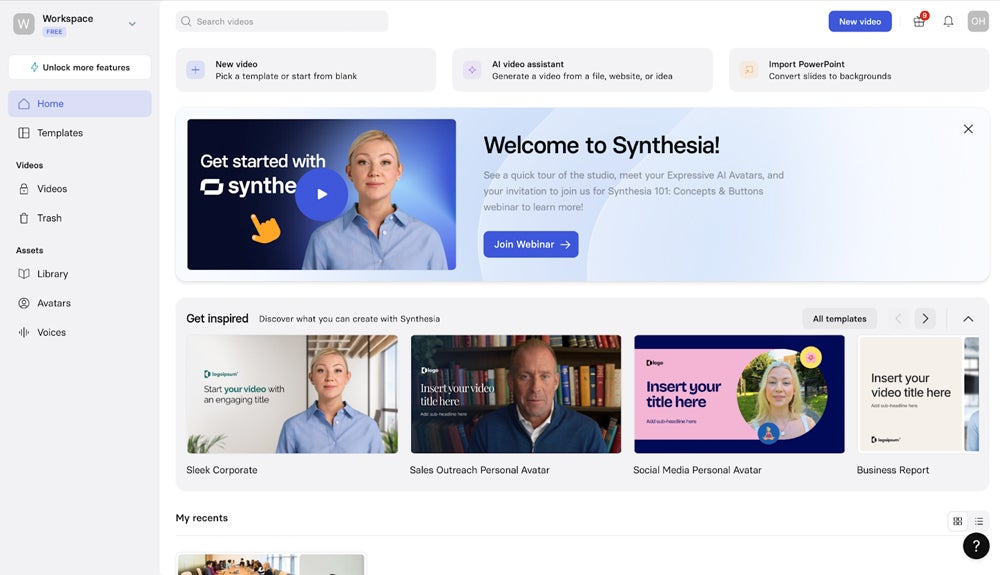
Pros and Cons
| Pros | Cons |
|---|---|
| Rapid video production turnaround | Limited flexibility in video editing |
| High-quality AI avatars and more than 140 stock languages | Authoring environment bugs |
| Ease of use | Occasional inaccuracies in lip-syncing with text |
Pricing
Trusted by 50,000+ teams, here’s what Synthesia’s pricing looks like:
- Starter: $18 per month, billed annually or $29 billed monthly
- Creator: $64 per month, billed annually or $89 billed monthly
- Enterprise: Available upon request
Features
- More than 230 AI avatar options
- Customizable avatars for brand-specific videos
- AI video assistant
- An extensive menu of video templates
- Various sharing and export options

Guidde
Best for automated tutorials
- Headquarters: Belmont, CA
- Founded: 2020
- Latest employee count: 11-50 employees
- Key products: Guidde
- Latest market cap: Private company valued at 30 million
Another top AI video generation company to make our list, Guidde allows users to create professional-quality video guides and tutorials without needing to be a production whizz. The platform is designed to be user-friendly, making it accessible even for those with limited technical skills. The company lists Yahoo, Ikea, Databricks, and DocuSign among its customers.
Guidde’s AI-powered tools, such as the Magic Capture feature and GPT-powered descriptions, are ideal for companies looking to take the heavy lifting out of video creation. This makes it particularly useful in corporate settings that rely heavily on visual materials, such as training and onboarding. The platform’s AI-generated voiceovers and easy-to-use editor allow users to customize their videos and share them across platforms like Zoom and Gmail. Guidde also scales easily for growing content demands, meaning businesses can expand without needing to make big additional investments.
Why We Picked Guidde
We chose Guidde for its ability to automate the creation of video assets quickly and efficiently, particularly tutorial-type content. The platform offers a variety of integrations with popular tools like Zendesk, Notion, and Slack, which makes it easy to incorporate into existing company workflows. With features like text-to-voice and multi-format output, Guidde supports various business needs, from customer support and onboarding to internal training and product tutorials. Customizable branding options also provide teams with the flexibility to align video content with their specific brand identity.
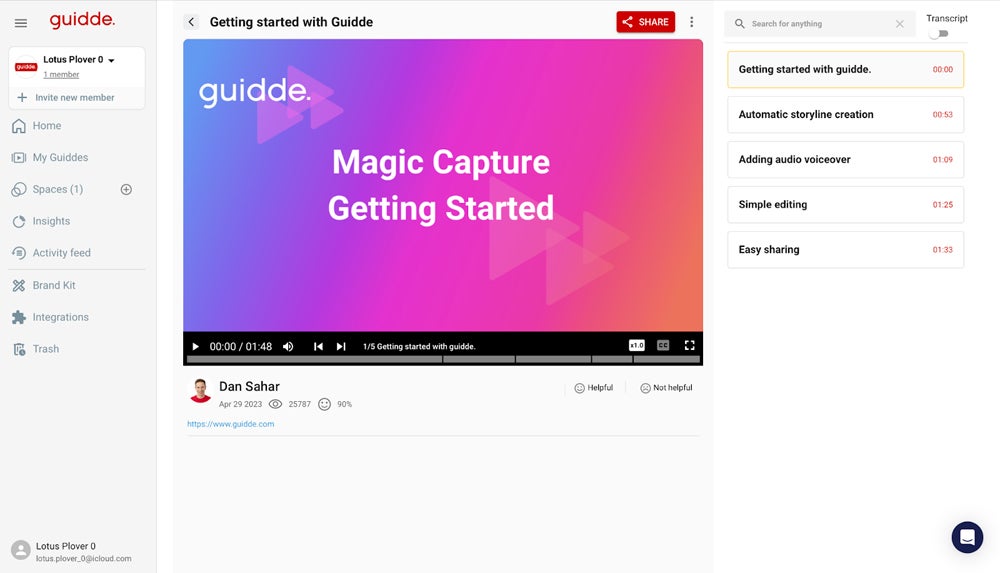
Pros and Cons
| Pros | Cons |
|---|---|
| Easy integration with over 20 platforms | Some limitations in editing features compared to more advanced tools |
| User-friendly interface suitable for all skill levels | Browser-based limitations (currently only supports Chrome and Microsoft Edge) |
| Offers a range of output formats and customization options | Needs a stable internet connection for optimal performance |
Pricing
Guidde offers the following subscription tiers:
- Free Plan: Up to 25 videos per month
- Pro: $16 per month with unlimited video creation
- Business: $35 per month with text-to-voice features, custom pronunciation, and video privacy controls
- Enterprise: Custom pricing
Features
- More than 20 platform integrations, including Zendesk and Slack
- Customizable branding and smart editing tools
- Supports multiple output formats including HTML, PDF, and video
- Built-in analytics to track and monitor presentations
- AI-generated voiceovers and multilingual support
Key Features of Generative AI Companies
Across the AI sector, different companies focus on contrasting core approaches. But all the best generative AI companies focus on factors like developing an extensive R&D pipeline, ethical approaches to AI, and building on high performance infrastructure.
Extensive R&D Pipelines and Products
Research and development is especially important to generative AI right now as the technology is still relatively new. This means potential AI use cases may still be untapped or unrealized. By experimenting with new algorithms and techniques, companies are able to improve the performance of their AI models and unlock new possibilities for AI applications. This is key to ensuring that their AI product effectively addresses real-world problems. It also helps AI companies stay ahead in an increasingly competitive market.
Ethical Approaches to Privacy and Compliance
Though current AI governance and ethics laws around the globe are limited, customers are demanding that generative AI companies share how they collect data, how they train models, and how models arrive at the solutions they produce. Compliance, transparency, and data privacy are at the forefront of generative AI discussions right now, especially with the introduction of the EU AI Act. This commitment helps build trust with users and meets growing regulatory demands for clear, understandable AI operations.
Solutions Built For Specific Business Needs
The top generative AI companies provide users with multiple tools or resources that explain how their solutions are used in various settings and workflows. In some cases, generative AI companies are beginning to build industry-specific versions of their solutions to cater to large markets that are particularly interested in generative AI-powered automations, analytics, and content generation. These tailored solutions enable organizations to deploy AI effectively and stay competitive in their respective markets.
Scalable High-Performance Computing Infrastructure
Regardless of use case, training and deploying large language models requires immense computational power. The top generative AI companies use and invest in scalable, high-performance computing infrastructure to handle complex calculations and large datasets. This infrastructure is essential for delivering fast, reliable AI services that can scale to meet the needs of many users and applications.
How to Choose the Best Generative AI Company for Your Business
Partnering with a generative AI company or selecting one of their product subscriptions is a big decision that is typically costly and resource-intensive. Before choosing the generative AI companies that you want to work with, it’s important to first assess your business’s generative AI requirements, budget, and any relevant in-house skills or resources that will help or hinder your ability to work with this kind of technology.
Understanding who you’re dealing with and what you need from them will also help you find a partner that provides the right technologies and support for starting—and continuing despite challenges—any generative AI operations you pursue.
Frequently Asked Questions (FAQs)
Is Alexa generative AI?
No, Alexa is a voice assistant that uses traditional AI, not generative AI. However, Alexa is from Amazon, which currently lags behind in generative AI compared to leading companies but remains strong in cloud AI with AWS.
What are the top generative AI models?
Some of the top generative AI models today include GPT-3 and GPT-4, Gemini, Claude, DALL-E 3, Stable Diffusion, Llama 3, Jurassic-2, and BLOOM. A variety of other popular and high-quality generative AI models exist for text, audio, image, video, and other types of content generation.
Who is leading in generative AI?
The key players in generative AI include OpenAI, Anthropic, Cohere, Glean, Jasper, and Hugging Face, as well as major tech companies and established leaders like Microsoft, Alphabet (Google), AWS, Meta, and NVIDIA. Beyond the players covered in this guide, other leaders include AI21 Labs, Midjourney, Notion, GitHub, and Tabnine.
How does generative AI work?
Generative AI technology uses neural network algorithms designed to replicate the workings of the human brain. These models are trained on huge datasets, which they analyze to build a knowledge base. By recognizing patterns and understanding the context within data, generative AI tools can create new content that reflects what they have learned.
Who owns generative AI?
No single entity owns generative AI. Companies like OpenAI, Google, Meta, and Anthropic develop it. When it comes to funding genAI, big tech firms (Microsoft, Google, Amazon), VCs, and governments support its growth.
What is the difference between generative AI and AI?
AI is broad — John McCarthy coined the term “artificial intelligence” in 1956. Generative AI is a subset of AI, which specifically creates content like text, images, and code. Check out our guide on AI vs. genAI for more details.
Bottom line: Top generative AI companies are developing rapidly
The generative AI landscape is diverse, with companies specializing in different areas, from text generation and language models to AI-driven video production and cloud-based services. This list of the top eight generative AI companies highlights the variety of approaches and solutions leading the market.
One thing that all of these AI companies have in common is that they compete in a sector that is evolving with exceptional speed. Consequently, whatever your requirements, these companies are likely working at top speed to create products to serve this market — both today and in the years to come.
Learn about the best large language models and find the LLM that’s best suited to your business needs.
